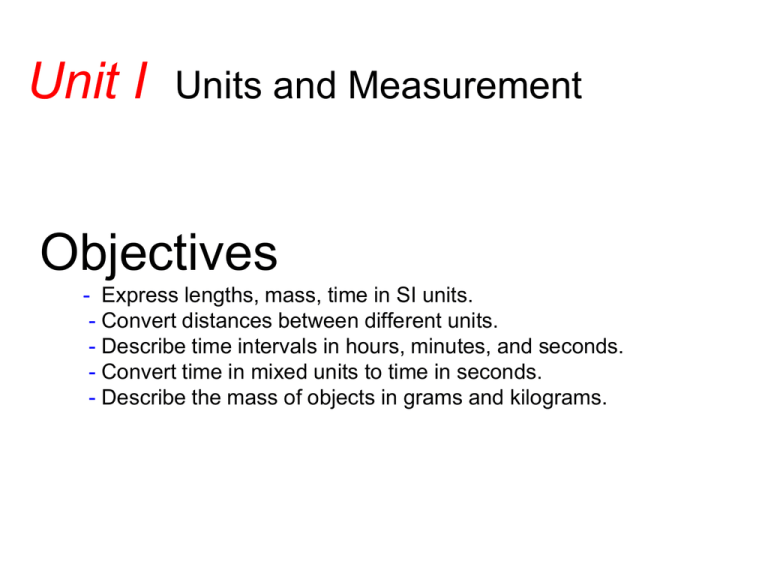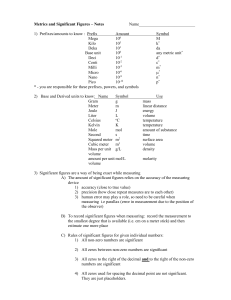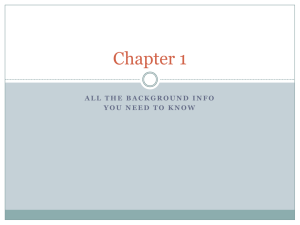UNITS
advertisement

Unit I Units and Measurement Objectives - Express lengths, mass, time in SI units. - Convert distances between different units. - Describe time intervals in hours, minutes, and seconds. - Convert time in mixed units to time in seconds. - Describe the mass of objects in grams and kilograms. It All Starts with a Ruler!!! I. Two Systems of Units 1. Metric system and International System of Units meter kilogram second Kelvin 2. English system inches, feet, yards, and miles. pound Fahrenheit 3. SI units meter (m): unit of length kilogram (kg): unit of mass second (s): unit of time meter, (SI unit symbol: m), is the fundamental unit of length in the International System of Units (SI). Originally intended to be one ten-millionth of the distance from the Earth's equator to the North Pole (at sea level). Since 1983, it has been defined as "the length of the path travelled by light in vacuum during a time interval of 1/299,792,458 of a second." National Prototype Metre Bar ( alloy of ninety percentplatinum and ten percent iridium) in International Bureau of Weights and Measures (BIPM: Bureau International des Poids et Mesures) to be located in Sèvres, France. kilogramme ( kg), is the base unit of mass in the International System of Units (SI) Is defined as being equal to the mass of the International Prototype of the Kilogram (platinum–iridium alloy) in International Bureau of Weights and Measures in Sèvres, France Second (sec or s) The second is the duration of 9,192,631,770 periods of the radiation corresponding to the transition between the two hyperfine levels of the ground state of the caesium 133 atom. UNITS (Systéme Internationale) 4. Examples The units for length, mass, and time (as well as a few others), are regarded as base SI units. These units are used in combination to define additional units for other important physical quantities such as force and energy. II THE CONVERSION OF UNITS A) relation between different units 1 ft = 0.3048 m 1 mi = 1.609 km 1 liter = 10-3 m3 Example 1.1 Grandma traveled 27 minutes at 44 m/s. How many miles did Grandma travel? 44𝑚 𝑠 = 44𝑚 𝑚𝑖𝑙𝑒 1609𝑚 1𝑠 𝑚𝑖𝑛 60𝑠 = 44 × 1.64𝑚𝑖𝑙 27𝑚𝑖𝑛 × 𝑚𝑖𝑛 = 44.3𝑚𝑖𝑙𝑒𝑠 60 mile/min=1.64mile/min 1609 44.3 miles B) How to convert Example 1 The World’s Highest Waterfall The highest waterfall in the world is Angel Falls in Venezuela, with a total drop of 979.0 m. Express this drop in feet. Since 3.281 feet = 1 meter, it follows that (3.281 feet)/(1 meter) = 1 and (1 meter) / (3.281 feet)=1 For meter feet: 3.281 feet Length 979.0 meters 3212 feet 1 meter Convert 100km to miles • A football field is 100 yards long. • What is this distance expressed in meters? C) unit convert chart D) Summary Reasoning Strategy: Converting Between Units 1. In all calculations, write down the units explicitly. 2. Treat all units as algebraic quantities. When identical units are divided, they are eliminated algebraically. 3. Use the conversion factors in reference tables. Be guided by the fact that multiplying or dividing an equation by a factor of 1 does not alter the equation. time • Two ways to think about time: – What time is it? • 3 P.M. Eastern Time on April 21, 2004, – How much time has passed? • 3 hr: 44 min: 25 sec. • A quantity of time is often called a time interval. Converting Mixed Units 1. 2. You are asked for time in seconds. You are given a time interval in mixed units. 1 hour = 3,600 sec 1 minute = 60 sec 3. Do the conversion: 1 hour = 3,600 sec 26 minutes = 26 × 60 = 1,560 sec 4. Add all the seconds: t = 3,600 + 1,560 + 31.25 = 5,191.25 sec Time Units E) Practice Example 2 Interstate Speed Limit Express the speed limit of 65 miles/hour in terms of meters/second. Use 5280 feet = 1 mile and 3600 seconds = 1 hour and 3.281 feet = 1 meter. m miles miles 1609m 1 hour Speed 65 11 65 29 s hour hour mile 3600 s Speed 29 meters second More practice 1. Convert 789 cm2 to m2 1m=100cm, 1m2=100cm *100cm=10000cm2 789𝑐𝑚2 = 789𝑐𝑚2 × 1𝑚2 2 =0.0789𝑚 10000𝑐𝑚2 2. Convert 75.00 km/h to m/s 75.00 km x 1000 m x 1 h___ = 20.83m/s h 1 km 3600 s III Limits of Measurement A). Accuracy and Precision • Accuracy - a measure of how close a measurement is to the true value of the quantity being measured. Example: Accuracy • Who is more accurate when measuring a book that has a true length of 17.0cm? Susan: 17.0cm, 16.0cm, 18.0cm, 15.0cm Amy: 15.5cm, 15.0cm, 15.2cm, 15.3cm • Precision – a measure of how close a series of measurements are to one another. A measure of how exact a measurement is. Example: Precision Who is more precise when measuring the same 17.0cm book? Susan: 17.0cm, 16.0cm, 18.0cm, 15.0cm Amy: 15.5cm, 15.0cm, 15.2cm, 15.3cm Example: Evaluate whether the following are precise, accurate or both. Accurate Not Accurate Accurate Not Precise Precise Precise --Why significant figures is important? --What does significant figures in a number consist of? --How to record measurement with proper significant figures? (digram) --List the rules in counting significant figures (zero rules) --Rules in calculation: Multiplication rule Division rule Addition & subtraction rule Rule in calculate average B) Significant Figures • The significant figures in a measurement include all of the digits that are known, plus one last digit that is estimated. Centimeters and Millimeters 40.16 cm The length of this miniature piezo electric motor is: 8.0 mm B.1) Finding the Number of Sig Figs: • All non-zero digits are significant. • Zeros between two non-zero digits are significant. • Leading zeros are not significant. • Trailing zeros in a number containing a decimal point are significant. • trailing zeros in a number not containing a decimal point can be ambiguous. (scientific notation is the solution) • One convention about trailing zero A bar placed over ( or under) the last significant figure; any trailing zeros following this are insignificant Example: 500 has 1 s.f. 500 has 2 s. f. 500 has 2 s.f. 500. has 3 s.f. Scientific notation Write number in form: 𝑎 × 10𝑏 1 ≤ 𝑎 < 10, b is proper exponent Standard decimal notation Scientific notation 2 2×100 300 3×102 4,321.768 4.321768×103 −53,000 −5.300×104 6,720,000,000 6.72000×109 0.2 2×10−1 0.000 000 007 51 7.51×10−9 How many sig figs? 100 2 10302.00 7 100.00 5 970 2 0.001 1 0.00250 3 5 1.0302x104 5 10302 B.2)Sig Figs in Addition/Subtraction Express the result with the same number of decimal places as the number in the operation with the least decimal places. Ex: 2.33 cm + 3.0 cm 5.3 cm (Result is rounded to one decimal place) B.3) Sig Figs in Multiplication/Division • Express the answer with the same sig figs as the factor with the least sig figs. • Ex: 3.22 cm x 2.0 cm 6.4 cm2 (Result is rounded to two sig figs) More example 2330 cm + 3.0 cm 2330 cm 2330𝑚 = 780𝑚/𝑠 3.0𝑠 B.4) Constant and Counting Numbers • Constant number have infinite sig. figs. • Counting numbers have infinite sig figs. • Ex: 3 apples • Eg. π=3.1415926…… C) practice 1.Calculate Volume of sphere with r 0.55m, 4 4 3 3 V r (0.55) 3 3 0.6969m 3 0.70m 3 2. Perimeter of the big circle P 2r 2 (0.55m) 3.4557 m 3.5m 2. Try the following 7.895 + 3.4= (8.71 x 0.0301)/0.056 = 𝐷 = 2.015𝑚 + 4.5 𝑚/𝑠 × 2.35𝑠 = 13m A= 𝜋𝑟 2 = 𝜋(1.25𝑚)2 = 4.91m2 IV Dimension Analysis – some simple rules 1.In 𝒎𝒖𝒍𝒕𝒊𝒑𝒍𝒊𝒄𝒂𝒕𝒊𝒐𝒏 𝒐𝒓 𝒅𝒊𝒗𝒊𝒔𝒊𝒐𝒏: The product unit is the product of the individual unit of each of those variables. (Ditto for ratios.) 2. 𝐈𝐧 𝒂𝒅𝒅𝒊𝒕𝒊𝒐𝒏 𝒐𝒓 𝒔𝒖𝒃𝒕𝒓𝒂𝒄𝒕𝒊𝒐𝒏: Different terms can only added together in a sum if each term in the sum has the same unit type. (Ditto for subtraction.) Example 1 - impossible: 40m + 20m/s or 12.5 s - 20m2 - Can Do: 50.0m + 20.55m=70.6m and 40m/s +11m/s =51m/s - Can Do, but need to convert into same unit: 1𝑚 40m + 11cm = 40m + 11cm × = 40.11m 100𝑐𝑚 Example 2 1.5 m 3.0 kg ? The above expression yields: a)4.5 m kg b)4.5 g km c)A or B d)Impossible to evaluate (dimensionally invalid) IV Scalars and Vectors 1. Definition A scalar quantity is one that can be described by a single number: temperature, speed, mass A vector quantity deals inherently with both magnitude and direction: velocity, force, displacement 2. Graph a Vector Arrows are used to represent vectors. The direction of the arrow gives the direction of the vector. By convention, the length of a vector arrow is proportional to the magnitude of the vector. 8 lb 4 lb 3. Vector Addition and Subtraction Often it is necessary to add one vector to another. A) example 1 3m 5m 8m B) Example 2 Example 2 continue 2.00 m 6.00 m Example 2 continue R 2.00 m 6.00 m 2 R 2 2 2.00 m 6.00 m 2 2 6.32m R 2.00 m 6.00 m C) When a vector is multiplied by -1, the magnitude of the vector remains the same, but the direction of the vector is reversed. Example 3 Given B AB A A A AB B B





